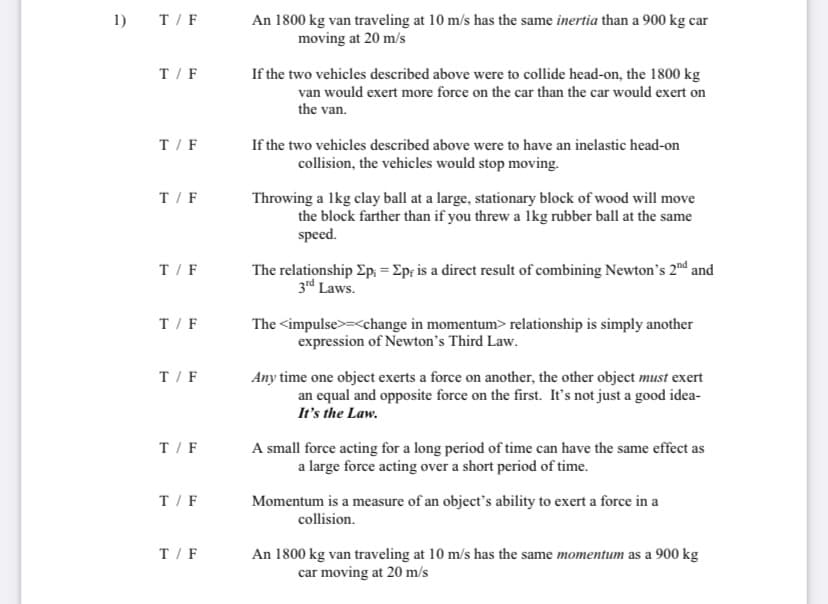1) T/ F An 1800 kg van traveling at 10 m/s has the same inertia than a 900 kg car moving at 20 m/s T/F If the two vehicles described above were to collide head-on, the 1800 kg van would exert more force on the car than the car would exert on the van. T/F If the two vehicles described above were to have an inelastic head-on collision, the vehicles would stop moving. T/F Throwing a lkg clay ball at a large, stationary block of wood will move the block farther than if you threw a Ikg rubber ball at the same speed. The relationship Ep, = Epr is a direct result of combining Newton's 2nd and 3rd Laws. T/F T/F The = relationship is simply another expression of Newton's Third Law. Any time one object exerts a force on another, the other object must exert an equal and opposite force on the first. It's not just a good idea- It's the Law. T/F A small force acting for a long period of time can have the same effect as a large force acting over a short period of time. T/F T/F Momentum is a measure of an object's ability to exert a force in a collision. T/F An 1800 kg van traveling at 10 m/s has the same momentum as a 900 kg car moving at 20 m/s
1) T/ F An 1800 kg van traveling at 10 m/s has the same inertia than a 900 kg car moving at 20 m/s T/F If the two vehicles described above were to collide head-on, the 1800 kg van would exert more force on the car than the car would exert on the van. T/F If the two vehicles described above were to have an inelastic head-on collision, the vehicles would stop moving. T/F Throwing a lkg clay ball at a large, stationary block of wood will move the block farther than if you threw a Ikg rubber ball at the same speed. The relationship Ep, = Epr is a direct result of combining Newton's 2nd and 3rd Laws. T/F T/F The = relationship is simply another expression of Newton's Third Law. Any time one object exerts a force on another, the other object must exert an equal and opposite force on the first. It's not just a good idea- It's the Law. T/F A small force acting for a long period of time can have the same effect as a large force acting over a short period of time. T/F T/F Momentum is a measure of an object's ability to exert a force in a collision. T/F An 1800 kg van traveling at 10 m/s has the same momentum as a 900 kg car moving at 20 m/s
College Physics
10th Edition
ISBN:9781285737027
Author:Raymond A. Serway, Chris Vuille
Publisher:Raymond A. Serway, Chris Vuille
Chapter4: The Laws Of Motion
Section: Chapter Questions
Problem 58AP: The force exerted by the wind on a sailboat is approximately perpendicular 10 the sail and...
Related questions
Question
Need major help

Transcribed Image Text:1)
T/F
An 1800 kg van traveling at 10 m/s has the same inertia than a 900 kg car
moving at 20 m/s
T/F
If the two vehicles described above were to collide head-on, the 1800 kg
van would exert more force on the car than the car would exert on
the van.
T/F
If the two vehicles described above were to have an inelastic head-on
collision, the vehicles would stop moving.
T/F
Throwing a lkg clay ball at a large, stationary block of wood will move
the block farther than if you threw a lkg rubber ball at the same
speed.
The relationship Ep, = Ep; is a direct result of combining Newton's 2nd and
3rd Laws.
T/F
T/F
The <impulse>=<change in momentum> relationship is simply another
expression of Newton's Third Law.
T/F
Any time one object exerts a force on another, the other object must exert
an equal and opposite force on the first. It's not just a good idea-
It's the Law.
T/F
A small force acting for a long period of time can have the same effect as
a large force acting over a short period of time.
T/F
Momentum is a measure of an object's ability to exert a force in a
collision.
T/F
An 1800 kg van traveling at 10 m/s has the same momentum as a 900 kg
car moving at 20 m/s
Expert Solution
This question has been solved!
Explore an expertly crafted, step-by-step solution for a thorough understanding of key concepts.
Step by step
Solved in 3 steps with 3 images

Knowledge Booster
Learn more about
Need a deep-dive on the concept behind this application? Look no further. Learn more about this topic, physics and related others by exploring similar questions and additional content below.Recommended textbooks for you

College Physics
Physics
ISBN:
9781285737027
Author:
Raymond A. Serway, Chris Vuille
Publisher:
Cengage Learning

Physics for Scientists and Engineers
Physics
ISBN:
9781337553278
Author:
Raymond A. Serway, John W. Jewett
Publisher:
Cengage Learning

Principles of Physics: A Calculus-Based Text
Physics
ISBN:
9781133104261
Author:
Raymond A. Serway, John W. Jewett
Publisher:
Cengage Learning

College Physics
Physics
ISBN:
9781285737027
Author:
Raymond A. Serway, Chris Vuille
Publisher:
Cengage Learning

Physics for Scientists and Engineers
Physics
ISBN:
9781337553278
Author:
Raymond A. Serway, John W. Jewett
Publisher:
Cengage Learning

Principles of Physics: A Calculus-Based Text
Physics
ISBN:
9781133104261
Author:
Raymond A. Serway, John W. Jewett
Publisher:
Cengage Learning

Physics for Scientists and Engineers with Modern …
Physics
ISBN:
9781337553292
Author:
Raymond A. Serway, John W. Jewett
Publisher:
Cengage Learning

Physics for Scientists and Engineers: Foundations…
Physics
ISBN:
9781133939146
Author:
Katz, Debora M.
Publisher:
Cengage Learning

College Physics
Physics
ISBN:
9781938168000
Author:
Paul Peter Urone, Roger Hinrichs
Publisher:
OpenStax College